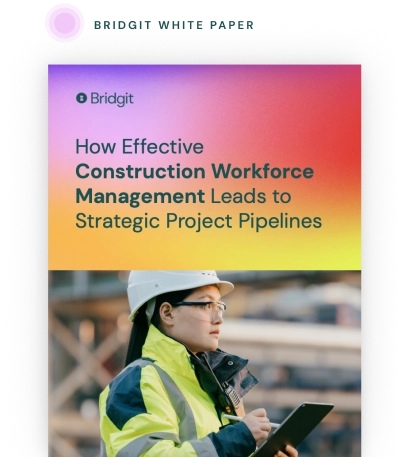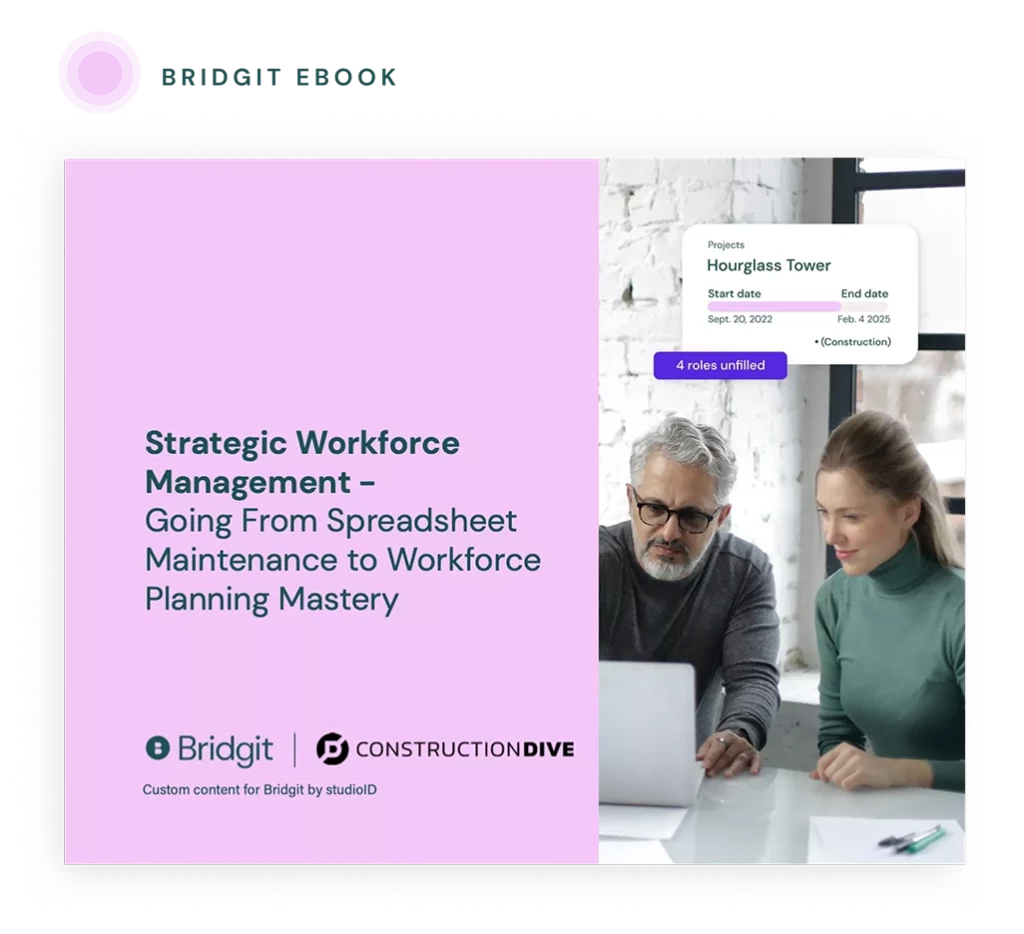Knowing how to write a bid for construction is an essential part of being a subcontractor. Keep reading to learn about the best bid-writing practices that will improve your bid-hit ratio.
Table of Contents
How to write a bid for a construction job
Let’s dive right into the steps for writing effective construction bids.
Know the bid process
Before you even begin writing bid proposals, you need to familiarize yourself with the process. Check out this article on construction bidding for a detailed walkthrough. In it, we cover important terminology along with the various stages of the bidding process.
Once you learn these details, you’ll be able to focus on crafting a great bid rather than stumbling through the process itself.
Review the project documents
Estimators and other professionals involved in the bidding process aren’t cheap. As such, it’s in your best interest to avoid putting them to work on bids that aren’t actually a good fit for your company.
Start by thoroughly reviewing the project documents. This should be easy if you’re using a construction bidding platform since clients typically make various detailed documents accessible on those sites. Check out this article for a great list of bidding sites to use.
If the client provides a bid sheet template, use it
Clients will often include construction bid sheet templates as part of a project’s documentation. You’d be wise to use these templates since it will make things easier on the client’s personnel responsible for reviewing several proposals.
It also communicates your willingness to adapt your way of doing things based on the client’s needs, which is an important trait to have throughout any construction project.
Of course, when clients don’t include construction bid proposal templates, you’ll need to create your own. We’ll look at that next.

Use your workforce data to create a competitive advantage
Download our white paper to see how effective workforce planning can help stay ahead of labor demands and create a strategic project pipeline.
Craft a professional construction bid proposal template if none is provided
When creating your own construction bid proposal template, there are several guidelines to follow. Let’s go line by line.
Heading
Every construction bid sheet template should include a heading that reads “Bid Proposal” so clients know exactly what they’re looking at even as your document gets passed around and separated from any initial correspondence.
Recipient information
Next, you need to include information about the recipient, including:
-
Name: See if the project listing specifies anyone in particular; otherwise, list the company.
-
Address
-
Phone number
-
Fax number
-
Job name: Include any unique identifiers you’re aware of, including the project’s number and exact address; don’t just say “Walmart” since the client may be building several of them.
-
Architect/general contractor
Services you intend to provide
Underneath the client information, you need to include a list of the services you intend to provide. This is among the most important parts of your bid since it will help the client understand exactly what is included in the price.
It’s crucial that you be specific with this list. We’ll get into that shortly.
Base bid
This is where you’ll include the dollar amount you’d like to be paid for the services listed above. You should arrive at this figure following a thorough estimating process aimed at ensuring your offer is fair for everyone involved.
This is also where you should specify a payment schedule if the client has not indicated one. Generally, your payment schedule will include details about any initial amounts owed along with the intervals at which you expect to be paid.
This is, of course, another very important consideration since it will have a direct impact on your company’s cash flow for the duration of the project.
Optional information
For many projects, the construction bid sheet template we’ve described up until this point will be more than enough. However, there are situations in which you might want to include additional information, such as the following.
Alternative Prices
Here’s where you can demonstrate how your price will change if certain services are added or removed. It’s generally recommended that you only include alternative prices if the project requirements are poorly defined or you get the sense that the client is open to suggestions.
If you include this section, it should be formatted to include:
-
Description: This will provide some context for the alternative price, including when you would recommend using it.
-
Add: If the alternative price is higher than your base bid, here’s where you’ll specify how much of an increase is involved.
-
Deduct: If the alternative price is lower than your base bid, here’s where you’ll specify how much of a decrease is involved.
-
Revised price: Don’t force the client to break out a calculator! Run the numbers yourself and include a revised price based on the addition or deduction you identified in the previous two points.
Include as many alternative prices as you think are necessary but keep in mind that too many will likely be confusing.
Unit prices
Occasionally, clients may request that you include unit prices. This amounts to a line-by-line description of each item, the quantity required, the unit of measure, and the price per unit.
It typically only makes sense to include unit prices when the project is small. For example, if you’re a subcontractor building a new deck for a client, they might want to know how many planks of wood you’re purchasing and at what cost. When building a skyscraper, though, unit prices may be less relevant.
Allowances
An allowance in construction terms is a specific dollar amount generally reserved for work that you’ll need to subcontract out.
It’s expected that these amounts won’t be 100% accurate but it will give the client an idea of what to expect. Subcontractors will fine-tune the figures once they conduct an on-site inspection.
Warranty information
Do you plan on providing any service after the structure has been built? This can be a major selling point and should be mentioned as part of your proposal.
Need to write an executive summary? Check out this guide for more information.
Be specific about the scope of work
Communication is key in construction. As such, you shouldn’t be surprised to learn that it’s a key part of learning how to write proposals for construction as well.
By communicating the exact intended scope of work within your bids, you’ll reduce the likelihood of clients setting unreasonable expectations. Additionally, you’ll open the door for clients to communicate their needs in advance if they happen to differ from the scope of work you’re proposing.
Of course, you may be less willing to set a restrictive scope of work if you really need or want the job. However, keep in mind that specificity can also be reassuring for clients. You’re not just telling them what they won’t get but also what they will.

Looking to be more strategic with your people?
We partnered with Construction Dive to outline the steps any contractor can take to be more strategic with their workforce management.
Communicate what happens in the event of unforeseen circumstances
While this may not neatly fit into any of the fields we outlined in the construction bid template section, you do need to think about and communicate how you plan on approaching unforeseen circumstances that might impact project financials.
These will most likely be notarized in the formal contract but it’s not a bad idea to specify any non-starters beforehand. For example, many contractors will specify upfront that clients are responsible for handling site issues like the removal of previously-undisclosed asbestos.
Write clear messages when communicating online
There’s little sense in crafting a beautiful construction bid proposal only to flub the delivery. Whatever medium you’re using to communicate with clients (email is popular these days), make sure you proofread messages carefully.
Typos aren’t the only thing to watch out for! You should also be aware of any potential issues regarding clarity.
Remember that format isn’t everything
Knowing how to write a bid for a construction job goes beyond formatting. You also need to make a credible, thoroughly-researched offer!
This begins at the estimating stage – learn more about it. Don’t forget to rely on your construction resource management data from similar past projects as well since this will be a valuable predictor of future expenses.
Prepare a professional bid every single time
Take care to produce professional bids for every project that requires one. Even if you have a long history with a particular client, there’s no guarantee that the same person who reviewed past proposals will be involved with this one. Treat every new endeavor as if you’re dealing with that client for the first time.
We hope this guide has been useful in showing you how to write a proposal for construction. While writing a proposal can seem daunting at first glance, it isn’t rocket science. By following best practices and producing a credible offer, you can greatly increase your chances of success.
For more construction management tips, visit the Bridgit Blog.
Bid Proposal FAQ
How do you format a construction bid?
Your construction bid should be formatted formally. You should include a heading, recipient information, a detailed list of services, the base bid amount, and payment terms. Depending on the bid, you may also include sections like alternative prices, unit prices, and allowances. We recommend you are specific about the scope of work and also include any warrant information.
How do you estimate a construction bid?
You can estimate a construction bid by reviewing project documents thoroughly, listing all required materials and labor, and calculating costs. Consider your markup for profit and how it could affect the competitiveness of your bid. You should also ensure your bid accounts for potential risks and unforeseen expenses.
How to write bid specifications?
Bid specifications should clearly define the project scope, including materials, standards, and workmanship quality. Outline deadlines, payment terms, and conditions for change orders. Ensure all requirements are precise to avoid misunderstandings.
How do you write a good bid?
A good bid is clear, detailed, and well-researched. Start with a thorough understanding of the project, provide a competitive and accurate estimate, highlight your qualifications, and ensure your proposal is professional and easy to read.


